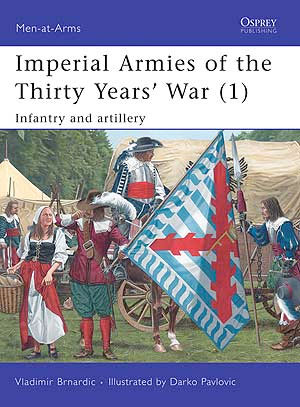
De Re Militari | Book Reviews
Vladimir Brnardic
Imperial Armies of the Thirty Years' War (1): Infantry and Artillery
Men at Arms 457. Botley: Osprey Publishing, 2009. ISBN 978 184 603 4473. US$17.95. 48pp.
From its inception in the late 1960s Osprey Publishing has filled a special niche in the annals of military publishing. Early on, it became an indispensible source for military modelers and war gaming enthusiasts. In this the 457th offering of this venerable series, Vladimir Brnardic and his illustrator, Darko Pavlovic, have put together a very useful volume on the armies of the Hapsburg Empire during the Thirty Year’s War. It includes the usual color plates and photos found in the entire Osprey series.
The book begins with a good, but brief, overview of the political and diplomatic situation in seventeenth-century Europe. In the section on the course of the war, it does a good job of tracing the three decade series of interconnected wars which made up the Thirty Year’s War. Special attention is given to the major part played by the Imperial commander Albrecht von Wallenstein throughout the Danish and Swedish phases of the war.
The majority of the book, as the title suggests, focuses on the infantry which made up imperial armies of the period, both musket and pike. Even though the title includes artillery, the work spends a relatively small amount of space discussing the artillery arm. Included in this section are discussions on the recruitment, training, discipline and organization of imperial soldiers. Also interesting are sections on the makeup of the regimental and company staff and the high command. The book does an excellent job throughout of explaining the roles of the officer corps in the overall effectiveness of the army.
The section on tactics describes the evolution of the tercio as the main battle formation of the Imperial army, although it is not listed in the small index. This part also deals with the changes in the imperial tactics when confronted by the Swedish linear system. Because of its lack of maneuverability and firepower, eventually the tercio was abandoned for the linear system. It is this development of this standardization of arms and tactics which is one of the lasting legacies of the Thirty Years War.
As with all Osprey titles, the highlight of the volume is the detailed discussion of the arms and armor of the Imperial musketeers and pikemen during the war. The color plates are well drawn and the photos and plate commentaries are very useful illustrations of the text. This section discusses the evolution of both the pike and musket over the thirty years of the war. This section of the text also describes innovations in infantry technology, such as the introduction of the caliver, the lighter, more manageable version of the musket. The segment ends with a useful discussion of infantry clothing, flags and field signs.
While Imperial Armies of the Thirty Years' War is an admirable and clear view of the Imperial infantry of the period, there are a number of issues which must be addressed. The volume would benefit from rudimentary page notes and a more expansive bibliography. Also the section on artillery could have been expanded, since the title does include artillery. One issue mentioned in the publisher’s blurb, is beginnings of a transformation from mercenary to national armies during this war. A mention of this topic would have made an interesting addition. Finally the discussion of the individual battles in the overview section could have been more detailed. These are small problems that detract very little from the overall value of this book as a functional first look at the makeup and arms of Imperial armies of the Thirty Years War.
 Jay Roberts
Jay Roberts